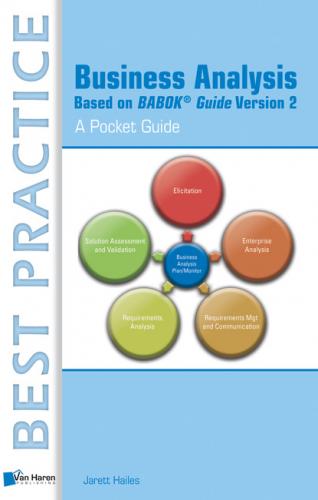■ Support for chapters to develop and engage the local community of Business Analysts within a region;
■ Learning opportunities through regular webinars, newsletters and best practice articles;
■ Certification of education providers to deliver training that aligns with the BABOK® Guide;
■ Special interest groups focused on the use of business analysis within a particular industry;
■ Sponsorship of the multi-disciplined annual Building Business Capability conference that enables Business Analysts to gain insights into techniques, ideas and approaches that can improve their day-to-day activities.
Additionally, IIBA offers two levels of certification. These certifications help organizations understand a base level of knowledge that the certified individual possesses and provides individuals with recognition for their experience as Business Analysts. Both of these certifications require completion of an exam based on the BABOK® Guide content:
■ Certification of Competency in Business Analysis (CCBA): for Business Analysts with some experience; individuals must have performed at least 3,750 hours of business analysis work;
■ Certified Business Analysis Professional (CBAP): designed to recognize those with an extensive depth and breadth business analysis experience; individuals must have performed at least 7,500 hours of business analysis work in the past 10 years.
1.5 About the BABOK® Guide
The BABOK® Guide defines the scope of what it means to perform business analysis and how the major concepts and tasks that make up this profession relate to one another.
BABOK® Guide History
• January 2005 (Version 1.0): outline and key definitions;
• October 2005 (Version 1.4): draft content of some knowledge areas;
• June 2006 (Version 1.6): details for most knowledge areas;
• October 2008 (Version 1.6 errata);
• March 2009 (Version 2.0): refine, simplify, and integrate knowledge areas, tasks and techniques.
Within each iteration of the BABOK® Guide, IIBA sought community involvement to ensure the end product was as relevant to as many practicing Business Analysts as possible and would represent best practices within the profession.
The BABOK® Guide provides a framework containing several key elements:
■ Knowledge areas: a collection of related tasks that form a major function of business analysis. The BABOK® Guide defines six knowledge areas, which are discussed in Section 1.7.
■ Tasks: a specific type of work that is performed in order to accomplish a particular goal. Each task within the BABOK® Guide has a specific purpose, description, set of inputs and outputs, elements, relevant techniques that can be applied, and set of stakeholders involved.
■ Techniques: describe a particular way that a task can be accomplished. Many of the techniques described within the BABOK® Guide are often a component of the overall work to be performed to complete a task, and some can be applied to multiple tasks.
■ Underlying competencies: represent certain basic aptitudes that Business Analysts require in order to be able to effectively perform the tasks defined within the BABOK® Guide.
■ Terms: standard definitions for common words that are used throughout the BABOK® Guide. The BABOK® Guide’s glossary provides clear descriptions for all major relevant terms.
1.6 Key Terms to Understand
Before reading further, it is important to understand some of the key terms used within the BABOK® Guide and this pocket guide:
■ Stakeholder: a group or individual who have interests that may be affected by an initiative, or who have influence over it;
■ Solution: a set of components that meet a business need by solving a problem or enable an organization to capitalize on an opportunity;
■ Requirement: a condition or capability needed by a stakeholder to solve a problem or achieve an objective;
■ Initiative: an effort undertaken to achieve a specific goal or objective.
Business analysis may be performed within a project environment or within the course of an organization’s ongoing operations. The term initiative will be used to denote the performance of business analysis in either context.
Requirements can be further classified into the following groupings to assist with business analysis tasks:
■ Business requirements: high level goals or objectives of the organization – they define why an initiative is being performed;
■ Stakeholder requirements: define what is needed for a particular stakeholder or collection of stakeholders;
■ Solution requirements: describe characteristics of a particular solution that will meet business and stakeholder requirements;
■ Transition requirements: capabilities which the solution needs to move the organization from its current state to the future state when the solution is implemented, but are not needed after the transition is completed.
Unless otherwise noted, this pocket guide uses the BABOK® Guide definition for all terms within its text.
1.7 Knowledge Areas, Techniques and Their Inter-Relationships
As mentioned above, there are six knowledge areas within the BABOK® Guide:
■ Business Analysis Planning and Monitoring: governs how all other business analysis tasks are performed;
■ Elicitation: how to identify and understand requirements;
■ Requirements Management and Communication: describes how to structure, organize and communicate requirements to stakeholders;
■ Enterprise Analysis: defines how to define business requirements and assess whether a particular problem is worthy of further effort in order to solve it;
■ Requirements Analysis: discusses how to assess requirements in order to understand what is needed to solve a problem or capitalize on an opportunity;
■ Solution Assessment and Validation: describes how to assess current and potential solutions and address any shortcomings, and to facilitate the transition to a new solution.
Knowledge areas describe a collection of related tasks, however these tasks may not necessarily be performed in sequence,
